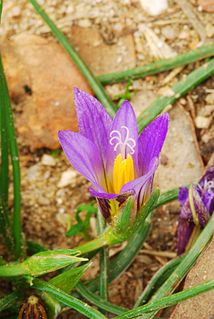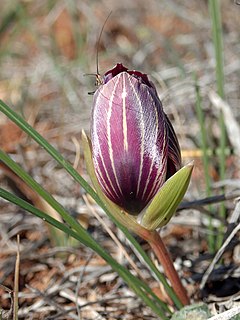
Sparaxis is a genus of flowering plants called the harlequin flowers. It belongs to the iris family Iridaceae with about 13 species endemic to Cape Province, South Africa.

A corm, bulbo-tuber, or bulbotuber is a short, vertical, swollen underground plant stem that serves as a storage organ that some plants use to survive winter or other adverse conditions such as summer drought and heat (perennation).

Iridaceae is a family of plants in order Asparagales, taking its name from the irises, meaning rainbow, referring to its many colours. There are 66 accepted genera with a total of c. 2244 species worldwide. It includes a number of other well known cultivated plants, such as freesias, gladioli and crocuses.

Gladiolus is a genus of perennial cormous flowering plants in the iris family (Iridaceae).

Crocosmia (montbretia) is a small genus of flowering plants in the iris family, Iridaceae. It is native to the grasslands of southern and eastern Africa, ranging from South Africa to Sudan. One species is endemic to Madagascar.

Watsonia is a genus of plants in the family Iridaceae, subfamily Crocoideae. Watsonias are native to southern Africa. The genus is named after Sir William Watson, an 18th-century British botanist.

Patersonia is a genus of flowering plants in the family Iridaceae commonly known as native iris or native flag. It was first described as a genus in 1807 by Robert Brown. It is native to Australia, New Guinea, New Caledonia, and insular Southeast Asia. The genus name is a tribute to the first Lieutenant Governor of New South Wales in Australia, William Paterson.

Freesia laxa, commonly known as flowering grass, is a small species of cormous flowering plant in the family Iridaceae, from eastern and southern Africa, from Kenya to northeastern South Africa. It is grown in gardens as an ornamental plant.

Crocoideae is one of the major subfamilies in the family Iridaceae.

Romulea bulbocodium is one of the best-known species from the genus Romulea. The plant, a member of the family Iridaceae, is native to the Mediterranean region and Sudan. It has many varieties and is occasionally used as ornamental plant.

Watsonieae is the second largest tribe in the subfamily Crocoideae and named after the best-known genus in it — Watsonia. The members in this group are widely distributed in Africa, mainly in its southern parts.

Moraea viscaria is the type species of the genus of Moraea in the Iridaceae that is named after the sticky secretion on the stem and branches.

Lapeirousia is a genus in the plant family Iridaceae. It is endemic to sub-Saharan Africa, about a third of the species occurring in fynbos.

Watsonia borbonica, the Cape bugle-lily, is a species of plant in the family Iridaceae that is native to South Africa.

Gladiolus watsonioides is a medium to high (½–1 m), herbaceous geophyte with sword-shaped leaves, flattened in the plain of the stem, and spikes of red funnel-shaped flowers, that is assigned to the iris family. In the wild, the species is restricted to the highlands of central Kenya and northern Tanzania, including on Kilimanjaro, Mount Kenya and the Aberdare Range. It is sometimes called Mackinder's gladiolus.

Romulea tortuosa is a herbaceous perennial geophyte in the family Iridaceae native to South Africa. It has a small corm in the soil, a few prostrate coiling leaves, and fragrant, trimerous yellow flowers, sometimes with six brown blotches on the inside near the bottom of the flower.
Geissorhiza melanthera is a small perennial plant of 14–18 cm high that is assigned to the Iridaceae. It survives the dry southern summer through storage of its resources in a corm. The stem carries two or three erect, sticky leaves of up to 18 cm (7 in) long, H-shaped in cross-section. This species blooms with six to twelve bilaterally symmetrical flowers, in a spike. Sometimes the spike has one side branch with fewer flowers. Each flower has six pale beige perianth lobes, a purple-red ring around a purple red tube and three blackish stamens. Each flower is subtended by two 1¼–2¼ cm long green bracts. This species was found flowering from the end of September till mid October. It is an endemic of the western slopes of the Piketberg mountains in the Western Cape province of South Africa.

Romulea toximontana is low a herbaceous perennial geophyte in the family Iridaceae native to South Africa. It has a small corm in the soil, several linear leaves, white trimerous flowers, yolk-yellow near the centre and with a purple wash on the outside. The 1997 IUCN Red List of Threatened Plants lists this species as rare.

Romulea monadelpha is a herbaceous perennial geophyte in the family Iridaceae native to South Africa. It has a small corm in the soil, a few thread-like leaves, and trimerous dark red flowers with elaborate markings on the inside near the bottom of the flower. It is called karoo satynblom in Afrikaans.
Eucomis schijffii is a bulbous species of flowering plant in the family Asparagaceae, subfamily Scilloideae, native to the Cape Provinces, KwaZulu-Natal and Lesotho. It was first described by William Frederick Reyneke in 1976. The reddish purple flowers appear in summer and are arranged in a spike (raceme), topped by a "head" of green leaflike bracts. It is cultivated as an ornamental plant and can be grown successfully outside where frosts are not too severe. The smallest of the species of Eucomis, it is particularly suited to being grown in rock gardens or containers.



















